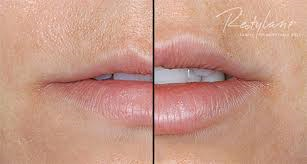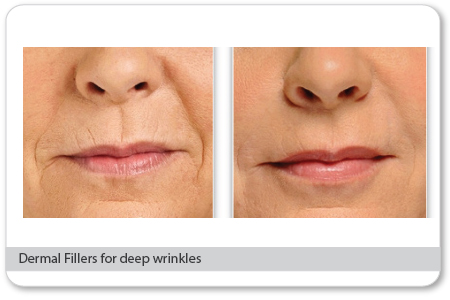What happens when I get a filler?
The procedure varies with the filler your dermatologist will use, the part of the body to be treated, and your medical history. Here are some general guidelines about what you can expect:
- Most filler treatments take between 15 and 30 minutes and require one office visit.
- Before getting the injections, you may need ice, an anesthetic applied to the skin, or a nerve block (an injection). This varies with the filler and area to be treated. Hands generally do not need anesthesia; lips often require a nerve block.
- Your dermatologist will inject the filler into the area, often giving you several injections to produce the best results.
- You may feel a stinging or burning sensation as the filler is injected.
- A few fillers require allergy testing to make sure you do not have an allergic reaction.
- If you need allergy testing, you must wait for the results from the allergy test before you can get the filler.
- If your own fat will be used as a filler, the entire treatment can often be completed in one day. You will first have a procedure called tumescent liposuction, which safely removes a small amount of fat from another area of your body. The fat removed from your body is then processed so that it can be injected into the area that needs more fullness.
What must I do after getting a filler?
Most patients can return to their everyday activities after leaving the office.
To reduce any redness and swelling from the injections, your dermatologist may recommend icing the area for 15 to 20 minutes before you leave.
Before you leave the office, you should be able to apply makeup.
After leaving the office, you should:
- Wait until the next day to exercise or do any other strenuous activity.
- Stay out of the sun and do not use a tanning bed or other type of indoor tanning.
- Avoid touching the treated area for three days, unless you receive instructions to massage the area.
- One filler, poly-L-lactic acid, requires you to gently massage the treated area for about 5 minutes several times a day for 1 to 2 weeks. Your dermatologist will tell you if you need to massage the area.
Is there downtime?
This varies with the filler. Most fillers do not cause downtime. Be sure to ask your dermatologist whether you will have downtime.
When will I see results after getting a filler?
This also varies with the filler. Most fillers fill the skin, so they produce immediate — or close to immediate — results. A filler also can stimulate your body to produce collagen, but this takes time.
Most fillers offer immediate results
| Filler |
When see results |
| Collagen |
Immediate |
| Hyaluronic acid gel |
Immediate |
| Calcium hydroxyl apatite |
Immediate |
| Poly-L-lactic acid |
2 or 3 weeks |
| Fat taken from your body |
Immediate |
| PMMA (polymethylmethacrylate) |
Immediate |
You may see other fillers advertised. All fillers listed above have been approved by the U.S. Food and Drug Administration (FDA), except for self-donated fat. This filler does not require FDA approval because it comes from your own body.
Will I look natural?
To get natural-looking results, the person injecting the filler must have expertise in placing the filler.
Dermatologists recommend not overdoing fillers. Your results will look more natural with a conservative approach. For example, patients who have very thin lips should not get dramatically fuller lips. Creating fuller lips in these patients could be extremely unflattering because the lips might start to resemble a duck’s bill.
How long will the results from fillers last?
Most fillers offer temporary results and require repeat treatments to maintain the results.
Temporary fillers offer one key advantage. These can be injected as needed to replace lost fullness. This is advantageous because no matter what we do, our skin continues to age.
How long fillers typically last
| Filler |
How long it lasts |
| Collagen |
2 to 3 months (often longer when treating scar) |
| Hyaluronic acid gel |
4 to 12 months |
| Calcium hydroxylapatite |
6 months to 1 year |
| Poly-L-lactic acid |
1 to 3 years |
| Fat taken from your body |
1 to 3 years (often longer when treating a scar) |
| PMMA (polymethylmethacrylate) |
permanent |
You should ask your dermatologist how long the recommended filler should last in the area you want treated.
When is it safe to get another treatment?
If you get a temporary filler, you can usually have another treatment when the signs of aging reappear.
What are the possible side effects?
After receiving filler injections, some patients have minor, temporary side effects where they were injected. You may have:
- Redness
- Swelling
- Tenderness
- Bruising (occasionally)
These side effects tend to clear within 7 to 14 days — if not earlier.
Serious side effects are more likely when the person injecting the filler does not have adequate medical training and experience. To protect your health, you should never get filler injections in a non-medical setting, such as non-medical spa, salon, or someone’s home.
When fillers are injected in a non-medical setting or by an inexperienced provider, reports of more serious side effects increase dramatically. These side effects include:
- Lumps.
- Ridges.
- Over-filled areas.
- Allergic reaction.
- Skin discoloration.
- Infection.
- Severe swelling.
What is the safety record for fillers?
This is one of the safest cosmetic treatments available. For years, dermatologists have been refining the use of fillers to diminish signs of aging. Today, dermatologists safely treat people of many ages and all skin colors.



